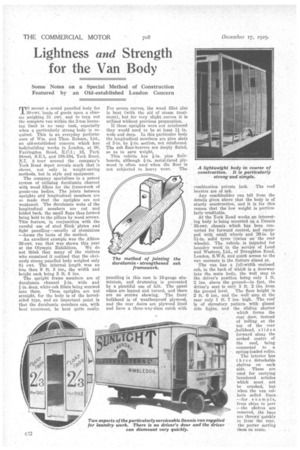Lightness and Strength
Page 64

If you've noticed an error in this article please click here to report it so we can fix it.
for the Van Body
Some Notes on a Special Method of Construction Featured by an Old-established London Concern TO mount a sound panelled body for 30-cwt. loads of goods upon a chassis weighing 31 cwt. and to turn out the complete van within the 2-ton licensing limit is no easy task, especially -when a particularly strong body is required. This is an everyday performance of Wm. and Thos. Robson, Ltd., an old-established concern which has bodybuilding works in London, at 60, Farringdon Road, E.C.1 ; 18, Park Street, S.E.1, and 188-194, York Road, N.7. A tour around the company's -York Road depot reveals much that is clever, not only in weight-saving methods, but in style and equipment.
The company specializes in a patent system of utilizing duralumin channel with wood fillets for the framework of goods-van bodies. The joints between uprights and longitudinal members are so made that the uprights are not weakened. The diiralumin webs of the longitudinal members are cut and folded back, the small flaps thus formed being held to the pillars by wood screws. This feature, in conjunction with the careful use of steel flitch' plates glad light panelling—usually of aluminium —forms the basis of the method.
An excellent example was the Albion 30-cwt. van that was shown this year at the Olympia Exhibition. We do not think that many of the visitors who examined it realized that the obviously strong panelled body weighed only 81 cwt. The internal length was no less than 9 ft. 3 ins., the width and height each being 5 ft. 3 ins.
The , upright frame members are of duralumin channel wide and i-in. deep, white-ash fillets being screwed into them. These uprights are not straight, for the body is of the barrelsided type, and an important point is that the duralumin members can, with heat treatment, be bent quite easily. For severe curves, the wood fillet also is bent (with the aid of steam treatment), but for very slight curves it is utilized without previous preparation.
If these uprights were not reinforced they would need to be at least 1 in. wide and deep. In this particular body the longitudinal members are pine slats of 3-in, by fin. section, not reinforced. The ash floor-bearers are deeply fluted, so as to save weight, This vehicle has fin, pine floor-. boards, although fin, metal-faced plywood is often used when the floor is not subjected to heavy wear. The panelling in this case is 16-gauge aluminium, and drumming is prevented by a plentiful use of felt. The panel edges are lapped and turned, and there are no screws showing. The front bulkhead is of weatherproof plywood, and the rear doors are plywood lined and have a three-way-slam catch with combination private lock. The roof bearers are of ash.
Any coachbuilder can tell from the details given above that the body is of sturdy construction, and it is for this reason that the low weight is particularly -creditable.
At the York Road works an interesting body is being mounted on a Dennis 30-cwt. chassis which has been converted for forward control, and equipped with small wheels and 26-in. by 3i-in. solid tyres (twins on' the rear wheels). The vehicle is intended for laundry work in the service of Loud and Western, Ltd., of Broughton Road, London, S.W.6, and quick access to the van contents is the feature aimed at.
The van has a full-width enclosed cab, in the back of Which is a doorway into the main body, the well step to the driver's position being only 1 ft. 2 ins, above the ground—in fact, the driver's seat is only 3 ft. 2 ins, from
the ground level. The floor height is 2 ft. 6 ins., and the well step at the rear only 1 ft. 7 ins. high. The roof is of clerestory pattern with glazed Side lights, and the sliding shutter which forms the rear door, instead of -rolling at the top of the rear .bulkhead, slides forward along the arched centre of the roof, being connected to a spring-loaded roller.
The interior has three detachable shelves on each side. These are used for carrying laundered articles which must not be crushed, but when the van collects soiled linen —for. example, from ships in port —the shelves are removed, the bags are thrown quickly in from the rear, the porter sorting them en route.












































































































